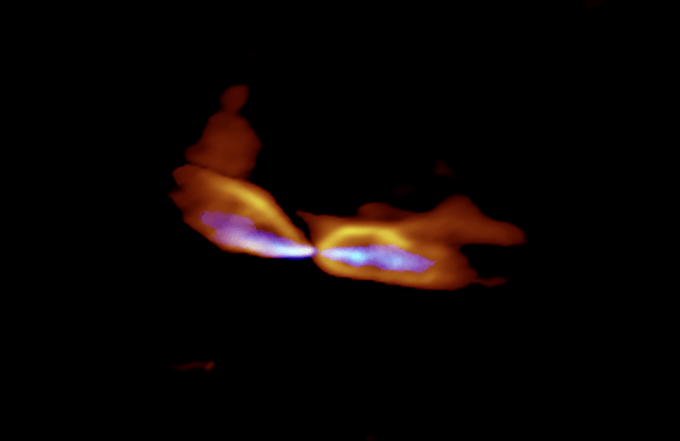Feb 27 2019
The mysterious origins of two varied gas streams from a baby star have now been exposed by astronomers. With the help of ALMA, the team discovered that there are misaligned axes in the gradual outflow and the intense speed jet from a protostar, and that the former began to be ejected much before the latter.
 ALMA image of the protostar MMS5/OMC-3. The protostar is located at the center and the gas streams are ejected to the east and west (left and right). The slow outflow is shown in orange and the fast jet is shown in blue. It is obvious that the axes of the outflow and jet are misaligned. (Image credit: ALMA (ESO/NAOJ/NRAO), Matsushita et al.)
ALMA image of the protostar MMS5/OMC-3. The protostar is located at the center and the gas streams are ejected to the east and west (left and right). The slow outflow is shown in orange and the fast jet is shown in blue. It is obvious that the axes of the outflow and jet are misaligned. (Image credit: ALMA (ESO/NAOJ/NRAO), Matsushita et al.)
While it has been a mystery with regards to the origins of these two flows, observations like these offer significant signs that both the gas streams were launched from various areas of the disk surrounding the protostar.
In the Universe, stars have an array of masses spanning from less than a tenth of the mass of the Sun to hundreds of times of that of the Sun. In order to get a deeper insight into the origin of this variety of masses, astronomers examine the stars’ formation process, that is, the cluster of cosmic dust and gas.
Although baby stars use their gravitational pull to collect the gas, the protostars eject some of the material, which, in turn, forms a stellar birth cry that gives clues to figure out the mass accumulation process.
ALMA was used by Yuko Matsushita, a graduate student at Kyushu University, and her team to view the comprehensive structure of the stellar birth cry from the baby star called MMS5/OMC-3 and they subsequently discovered that there are two types of gaseous flows—a fast jet and a slow outflow. Although a few examples with two flows have been observed in radio waves, the MMS5/OMC-3 is considered to be unique.
Measuring the Doppler shift of the radio waves, we can estimate the speed and lifetime of the gas flows. We found that the jet and outflow were launched 500 years and 1300 years ago, respectively. These gas streams are quite young.
Yuko Matsushita, Study Lead Author and Graduate Student, Kyushu University.
The results of the study have been reported in the Astrophysical Journal.
A more interesting fact was that the axes of the two flows were found to be misaligned by 17 degrees. Owing to the precession of the central star, the flows’ axis can be altered over extended periods. However, in this case, the gas streams were extremely new, forcing the team to surmise that the misalignment is caused due to the launching process and not by the precession.
A couple of competing models are available for the formation mechanism of the outflows and jets of the protostar. According to some scientists, the two streams are formed autonomously in various areas of the gas disk surrounding the central baby star, whereas others suggest that the collocated jet is initially formed and this subsequently forms the slower outflows by entraining the surrounding material. In spite of significant studies, astronomers are yet to find a conclusive answer. While a misalignment in the two flows might happen in the “independent model,” it is rather complicated in the “entrainment model.” The research team also discovered that the ejection of outflow occurred much earlier than the jet. This obviously supports the “independent model.”
The observation well matches the result of my simulation.
Masahiro Machida, Professor, Kyushu University.
Ten years ago, Machida used a supercomputer operated by the National Astronomical Observatory of Japan to carry out groundbreaking simulation studies. During the simulation process, the wide-angle outflow is allowed to eject from the external part of the gaseous disk surrounding a prototar, whereas the collimated jet is launched autonomously from the internal part of the disk. Machida continued that “An observed misalignment between the two gas streams may indicate that the disk around the protostar is warped.”
ALMA’s high sensitivity and high angular resolution will enable us to find more and more young, energetic outflow-and-jet-systems like MMS 5/OMC-3. They will provide clues to understand the driving mechanisms of outflows and jets. Moreover studying such objects will also tell us how the mass accretion and ejection processes work at the earliest stage of star formation.
Satoko Takahashi, Study Co-Author and Astronomer, National Astronomical Observatory of Japan and The Joint ALMA Observatory.
Paper and research team
The results of these observations were published by Matsushita et al., titled “A Very Compact Extremely High Velocity Flow toward MMS 5/OMC-3 Revealed with ALMA” in the Astrophysical Journal released in February 2019.
Yuko Matsushita (Kyushu University), Satoko Takahashi (Joint ALMA Observatory/National Astronomical Observatory of Japan/SOKENDAI), Masahiro Machida (Kyushu University), and Koji Tomisaka (National Astronomical Observatory of Japan/SOKENDAI) are the research team members.
The study was supported by JSPS KAKENHI (No. 17K05387, 17H06360, 17H02869, 15K05032) and the Science Visitor Program of the Joint ALMA Observatory.